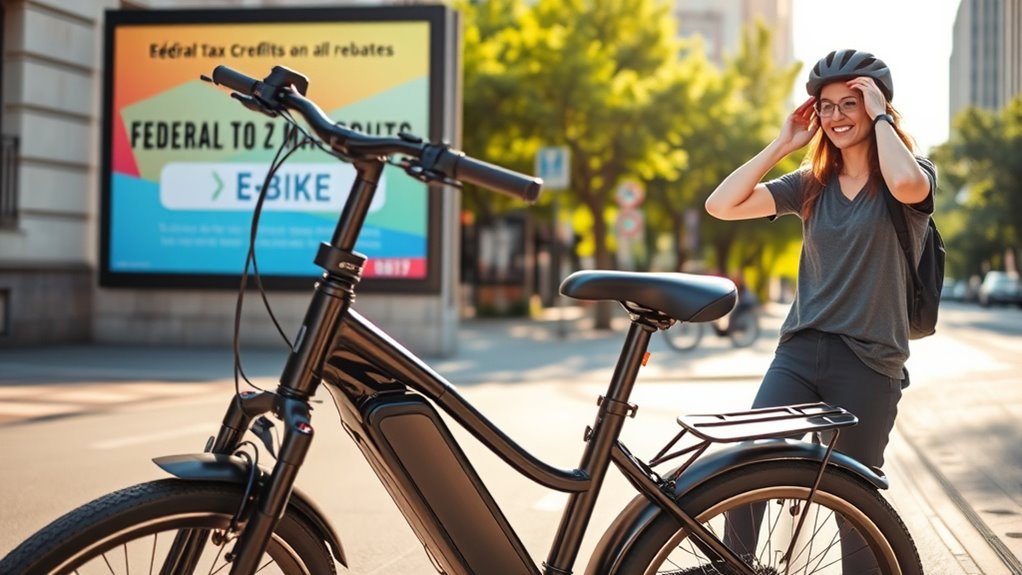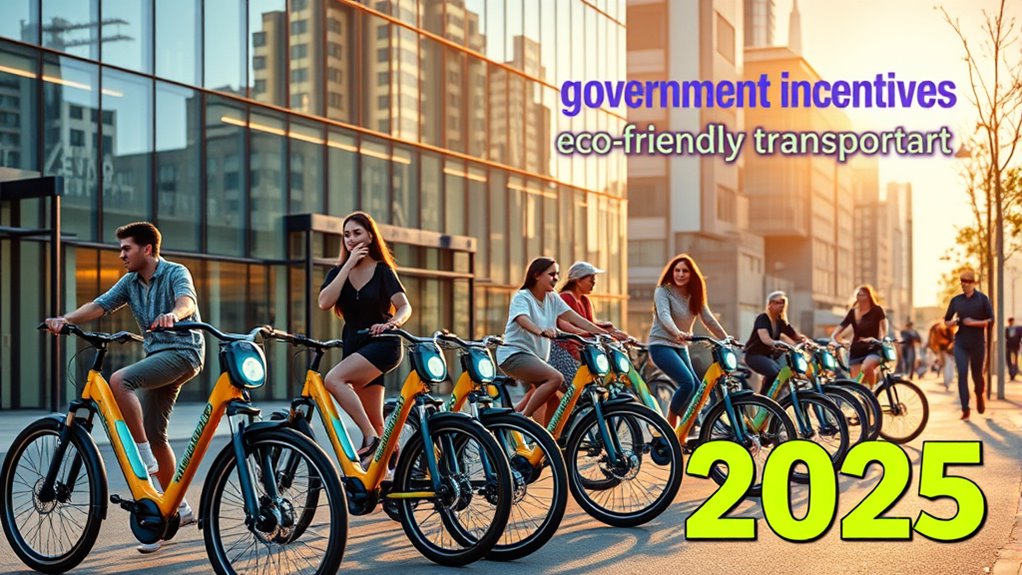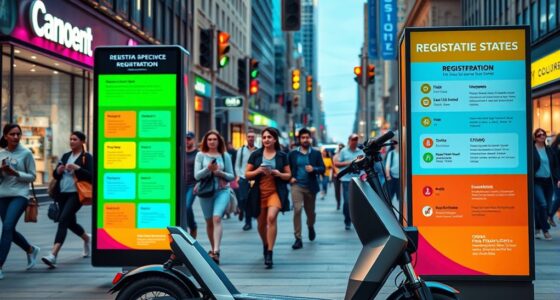In 2025, you can benefit from federal tax credits and rebates that lower your e-bike costs and support better battery tech and charging stations. Many states and cities also offer additional subsidies, making e-bikes even more affordable. If you’re a business or fleet manager, grants and discounts might be available to help you upgrade sustainably. To maximize these perks and learn how to save more, keep exploring the latest government programs and incentives.
Key Takeaways
- Federal tax credits and rebates significantly lower e-bike purchase costs through incentives and subsidies.
- State and local programs offer additional subsidies, especially for urban infrastructure and recycling initiatives.
- Businesses can access grants and fleet discounts to promote eco-friendly transportation solutions.
- Federal incentives support advancements in battery technology and expand charging infrastructure.
- Community support features and updated incentive information encourage widespread e-bike adoption in 2025.
Federal Tax Credits and Rebates

Are you aware that federal tax credits and rebates can substantially reduce the cost of purchasing an e-bike? These incentives often encourage improvements in battery technology, making e-bikes more affordable and efficient. A focus on advanced battery technology means longer-lasting, quicker-charging batteries, which enhances your riding experience. Additionally, federal programs support the expansion of charging infrastructure, making it easier to find charging stations and keep your e-bike powered up. By taking advantage of these incentives, you not only save money but also promote cleaner transportation. Keep an eye on available federal rebates, which can directly lower your purchase price, and ensure you’re aware of the latest developments in battery technology and charging infrastructure that make e-biking more accessible and convenient than ever. Community support features can also help you stay motivated in adopting eco-friendly transportation options.
State and Local Subsidy Programs

Building on federal incentives, many states and local governments offer their own subsidy programs to make e-bikes even more affordable. These programs often support urban infrastructure projects, like dedicated bike lanes, and promote sustainable practices such as battery recycling. To illustrate, here’s a snapshot of some programs:
| State/City | Subsidy Amount | Key Focus Area |
|---|---|---|
| California | $500 | Urban infrastructure |
| New York | Up to $1,000 | Battery recycling initiatives |
| Texas | $300 | E-bike affordability |
| Oregon | $700 | Promoting eco-friendly transport |
These programs help reduce costs and encourage eco-conscious commuting, making e-bikes accessible and environmentally sustainable.
Incentives for Businesses and Fleet Managers

How can businesses and fleet managers capitalize on e-bike incentives to boost sustainability and cut transportation costs? One way is by applying for corporate grants that support eco-friendly transportation initiatives. These grants can help offset the initial purchase costs of e-bikes, making adoption more affordable. Additionally, many programs offer fleet discounts, allowing you to buy multiple e-bikes at reduced prices. This not only lowers your overall expenses but also demonstrates your company’s commitment to sustainability. Implementing e-bikes into your fleet can improve delivery times, reduce emissions, and enhance your brand image. Utilizing personal growth strategies can further support your team’s motivation to adopt eco-friendly practices. By leveraging these incentives, you can upgrade your transportation options efficiently while supporting environmental goals and saving money in the long run.
Frequently Asked Questions
Are There Specific Eligibility Criteria for E-Bike Incentives?
You should check the eligibility requirements for e-bike incentives carefully, as they can vary by program. Typically, you’ll need to meet criteria like residency status, income limits, or purchase date. Be aware of incentive limitations, such as maximum rebate amounts or specific bike models covered. Ensuring you understand these details helps you qualify smoothly and get the most benefit from available programs. Always review official guidelines before applying.
How Do I Apply for Government E-Bike Incentives?
It’s a coincidence that you’re asking about applying for government e-bike incentives, as many programs align with evolving electric bicycle regulations and urban transportation policies. To apply, start by checking your local government’s transportation website or incentive portal. Gather necessary documents, like proof of purchase and registration, then complete the online or in-person application. Keep an eye out for deadlines and follow instructions carefully to guarantee your application qualifies.
Do Incentives Vary by E-Bike Brand or Model?
Incentives typically don’t vary by e-bike brand or model but depend on brand-specific policies and model eligibility. You should check the local or federal guidelines because some programs may have restrictions on certain brands or newer models. Always verify if your e-bike qualifies under the specific incentive’s criteria, as eligibility can change based on the model’s features or certification status. This way, you guarantee you get the maximum benefit.
Are There Upcoming Changes to E-Bike Incentive Programs?
Ah, the ever-elusive crystal ball of government policy—just when you think market trends are set, they throw a curveball. As of now, there are no announced changes to e-bike incentive programs, but keep an eye out; policy shifts often sneak in when you least expect them. Staying informed is your best bet to ride the wave of upcoming incentives, which could suddenly boost your e-bike adventures.
What Documentation Is Needed to Claim Incentives?
When claiming incentives, you’ll need proof of e-bike purchase, such as receipts or invoices, and possibly documentation of E bike maintenance records. Some programs require proof of battery recycling participation, like recycling receipts or registration. Check specific program guidelines, as they may ask for additional forms or identification. Keeping organized records of your e-bike’s maintenance and recycling efforts will make the process more straightforward and ensure you meet all incentive requirements.
Conclusion
By taking advantage of these incentives, you can considerably cut costs when switching to e-bikes. For instance, a small delivery business in California saved thousands through federal credits and local rebates, enabling them to expand their fleet affordably. As more incentives roll out in 2025, now’s the perfect time to contemplate upgrading. Embrace the savings and sustainability benefits—your wallet and the environment will thank you.









